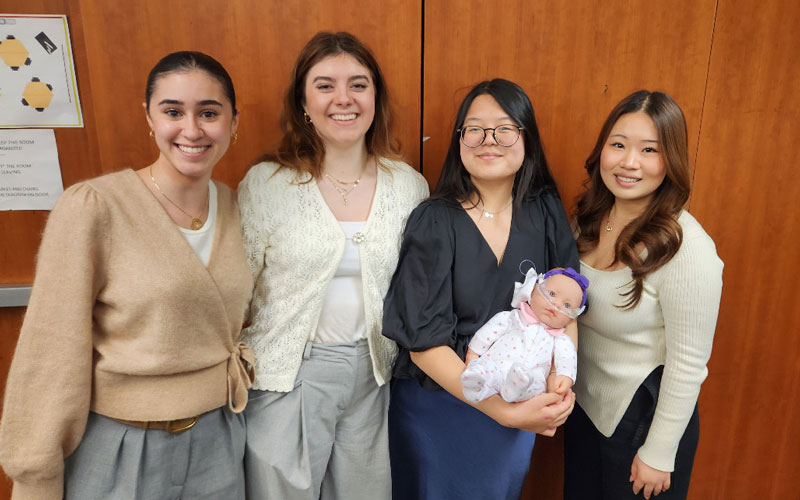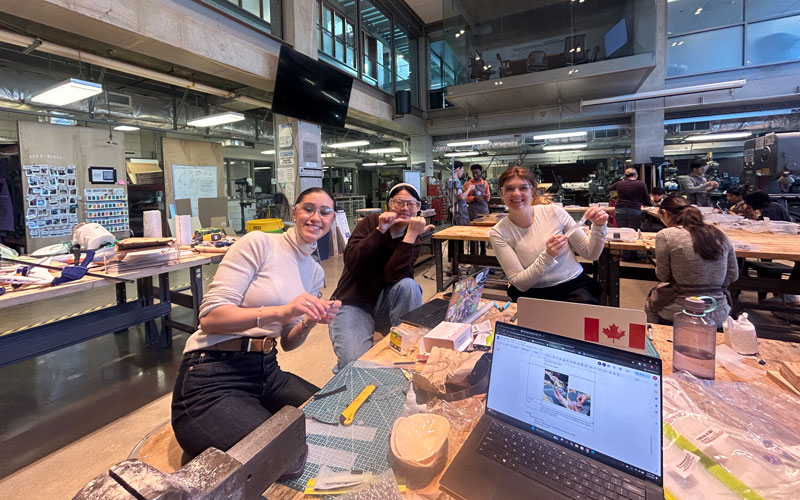Designing Relief
Student team tackles painful complication of infant feeding tubes with Lurie Children’s Hospital

When Christina Kim (’26), Sophia DeLuca (’26), Lily Li (’26), and Dalia Diab (’26) began their DSGN 384: Interdisciplinary Product Design course at the Segal Design Institute, they didn’t expect their class project would evolve into a potentially patentable medical device.
Partnering with Ann & Robert H. Lurie Children’s Hospital, the team initially set out to address a common issue: clogged nasogastric (NG) feeding tubes. But during on-site observations and conversations with caregivers, their focus shifted.
"User observation in this project was very important,” Kim said. “We could see that skin irritation was a bigger problem."
Nurses and caregivers revealed that medical tape used to secure NG tubes often caused painful facial rashes in infants — so severe that babies sometimes pulled their tubes out. While tube clogging remained a concern, the students realized that preventing rashes could have a broader impact.
"We got enough validation from the doctors and nurses at Lurie's that skin irritation was a key pain point in this area to justify a switch," DeLuca (’26) said.
That key insight led to a breakthrough: a three-part system that eliminates the need for adhesive tape, reduces strangulation risk from loose tubing, and helps prevent infants from dislodging their own NG tubes.
The real challenge: Pain, infection, and family stress
For infants with complex cardiac conditions who undergo surgery, NG feeding tubes are often necessary for four to six months, or longer. The traditional method of securing these tubes with medical adhesive tape creates significant problems, according to Amy S. Lay, attending physician and associate medical director of the Regenstein Cardiac Care Unit at Lurie Children’s Hospital.
“It can be a pretty significant rash,” Lay said. “Most of the time with a rash, you can say ‘remove the problem and let it heal.’ Well, you can’t do that because if you switch it out it’s going to occur on the other side of the face. The other problem is it can get super infected to the point where we’ve had to call dermatology. It hurts and it can bleed.”
Beyond the medical implications, there’s an emotional toll on the already stressed families.
“The superficial side is you’ve got this rash on a baby’s face,” Lay said. “But it ends up being very important for families who were already stressed. It’s just one more stressor, and if it hurts, the baby’s going to cry more.”
A systematic design approach
 The team developed their solution through a rigorous process of iteration, testing, and continuous feedback. The group faced a unique challenge: designing for infants without being able to test directly on them. To overcome this, they used an anatomically correct doll for sizing and created adult-sized versions for caregivers and clinicians to wear and evaluate.
The team developed their solution through a rigorous process of iteration, testing, and continuous feedback. The group faced a unique challenge: designing for infants without being able to test directly on them. To overcome this, they used an anatomically correct doll for sizing and created adult-sized versions for caregivers and clinicians to wear and evaluate.
The team’s final design consists of three integrated components:
- A clear, silicone tube holder that runs under the nose and secures the NG tube
- An adjustable headband that holds the tube holder to a child’s face with safe, consistent pressure
- A storage pouch that contains excess tubing to prevent strangulation risks
The materials were carefully selected for safety and comfort. The team used FDA-approved silicone and a cotton lining for the headband, which Kim noted is “hypoallergenic and can be washed many times because it’s a very strong material.”
“One of the things we were really focused on was long-term use,” Diab (’26) said. “This can fit patients zero to 12 months, so it can be used however long a child needs during their treatment.”
Making an impact
The innovation department at Lurie's Stanley Manne Research Center is now exploring whether the design can be developed into a patented product. When Lay showed the prototype to nurses and nurse practitioners who work with these infants daily, they were impressed.
 "Parents come up with some pretty innovative workarounds,” Lay said. “This is not something they have seen a parent come up with. What’s promising is that it’s a non-adhesive and the fact that it can be versatile. It’s also clear, so it makes the tube not as obvious.”
"Parents come up with some pretty innovative workarounds,” Lay said. “This is not something they have seen a parent come up with. What’s promising is that it’s a non-adhesive and the fact that it can be versatile. It’s also clear, so it makes the tube not as obvious.”
Beyond addressing a practical need, this project proved transformative for the students involved. For them, this experience offered valuable insights into healthcare design.
"As a biomedical engineer, it's not only our goal to solve the problem but to approach the patients and users with empathy," Kim said. "We’re trying to solve this problem and we're also trying to just make their life easier."
This empathetic approach resonated even with team members who initially felt out of their element.
“I was really intimidated going into this project because I don’t have any medical experience,” said Diab, who is studying Manufacturing and Design Engineering. “But this project gave me the confidence to trust that these design skills are very transferrable. I found myself afterwards searching for jobs and internships in healthcare-based design, whereas six months ago I never would have done that because I didn’t think that was for me.”
The interdisciplinary nature of the team turned out to be one of its greatest strengths.
“This class has taught me a lot about working in a space that you’re not comfortable with,” Li said. “As a biology major, I had no experience in engineering. Learning a human-centered design approach has given me a new perspective on how I can enter the medical field and not just maintain a patient’s quality of life, but make it even better.”
